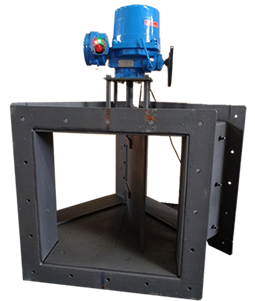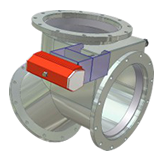Products


Although any two dampers can be used to divert flow, Diverter dampers are a common way to divert a flow of gas from one outlet to another.
Diverter dampers are simple and can withstand high temperatures. The blade is located out of the gas stream, so erosive particles do not impact directly on the surface. Disadvantages include the large side of the frame and drive, and flutter of the blade when moving across the flow or when splitting flow between outlets.
The frame of a diverter damper represents a large piece of ducting with a branch in it. This frame requires reinforcement to ensure that the seal seats will retain reasonable flatness at temperatures near 900°F.
The blade itself is built up to give stiffness for tight sealing and flutter resistance. Hinging of the blade is at the duct top and at the aperture edge farthest from the source of hot gas. This mounting allows upstream pressure to help seat the blade tightly.
One type of a seal consists of a tadpole-type gasket or rolled-up inconel fiber sheet, which is compressed by the closing blade. The blade strikes a metal bar stop, so the gasket is not compressed beyond the desired shape. The gasket completely surrounds the exit port, leaving a clearance along the duct wall, so the blade can swing freely.
Diversion of gas-turbine exhaust is not the only application for the swinging blade damper. In a straight duct, it can act as a bypass damper, as in flue gas desulfurization work.
Advantages of Diverter Dampers:

Disadvantages of Diverter Dampers:
A Gas Flow Diverting Damper is a three way damper ideally suited for gas flow diversion in bypass systems and is used for alternate isolation. A diverter replaces two guillotines or louver dampers and is very cost effective as it utilizes a duct transition piece providing three ports. Only one actuator system is required, simplifying flow control and making improper isolation impossible.
They are used widely in bypass stacks of gas turbine combined cycle plants. The frame of a swinging blade damper represents a large piece of ducting with a branch in it. This frame requires reinforcement to ensure that the seal seats will retain reasonable flatness at elevated temperatures. The blade itself is built to give stiffness for tight sealing and flutter resistance. The hinging of the blade is at the top of the duct and at the aperture edge farthest form the source of hot gas. This mounting allows upstream pressure to help seat the blade tightly.
We have embarked our presence in this discipline by offering qualitative Industrial Diverter. Designed to perfection, these offered products are able to meet specific application processes followed in areas like cement plants, power plants and others. The precision design of these diverter allows easy transfer of material from one feed point to other discharge points. These offered products are available with us in different technical specifications addressing divergent demands of the clients.
Features: